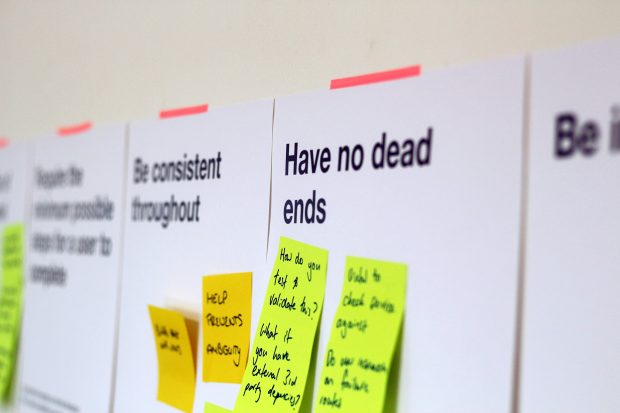
In the world of service design, there hasn’t always been an answer to the question of ‘what does a good service look like?’. Our service design training shows aspects of it, and we do have examples of what we mean, but we don’t have one complete picture.
Lou Downe, GDS’s former Director of Design, identified this problem and suggested an initial answer to the question of ‘what do we mean by a good service?’.
We wanted to turn this into guidance for the Service Manual to show users across government what a well-designed service looks like.
Using the wisdom of the crowd
Given that we were defining the fundamentals of a topic, it seemed important to incorporate as much knowledge as we could. And there are a lot of people out there who know a lot about service design.
Lou Downe, and Ben Tate – the current Joint Head of Service Design and Standards at GDS – started this off with senior civil servants working in policy, operations and delivery. At one of the Transforming Together events focused on the future of the public service, they asked people to describe the best and worst public service experiences that they’d either seen or could imagine. Lou's initial blog post was based on this feedback.
Then, we asked a lot of designers for their thoughts on what a good and a bad service looks like. We did this in workshops, at conferences, in training sessions and through an open Google doc.
Gathering wide-ranging and detailed feedback was like an experiment in crowdsourcing as much expertise as we could.
It’s worth saying that this isn’t how all Service Manual guidance is produced. We only have 2 to 3 content designers working on it, and we wouldn’t get much done if it was!
Iterating the content
We took our draft content to meetups, such as the cross-government service design meetup and the service community day organised by the Department for Work and Pensions.
We asked people to share their thoughts on what they understood by each of the characteristics of a good service. We also wanted to know to what extent their services had those characteristics.
People had a chance to think about how they might use the new guidance, and how we could make the content even better.
The topic seemed to strike a chord. At one of the meetups, people even skipped the coffee and biscuits so that they could continue their discussions in the room.
A version of these exercises is now part of the service design training, where people have also told us about the barriers and challenges they might face when trying to improve the different service characteristics. This has helped us improve the guidance even more.
We also took iterated versions of the content to wider audiences at meetups in London and even conferences abroad – in Brazil, Germany and the US – to ask for feedback and make sure the latest rewrites were clear and easy to understand.

Turning everything into Service Manual content
Most of the Service Manual is about how to do things, not what things look like. It covers topics like how to make your service accessible, how to do user research well and how to apply the principles of agile working.
But we thought this content could work well as an introduction to service design – a set of starting points, with links to places where you can find out more.
The editing took time. We went through all the feedback in a series of 2-hour workshops, using a pair writing approach.
Getting lots of feedback also meant answering lots of questions.
When we tested the content out, people had questions about how it related to the Service Standard and other sets of principles in the world of government service design.
This helped us more clearly define it as guidance on ‘the characteristics of a good service’.
Now there is also a translation for German public servants. And Lou Downe is writing a book about good services. During Services Week, Lou also spoke about the past, present and future of good public services, illustrated with service examples for each of the characteristics. You can watch a recording of the talk on YouTube.
Help us make Service Manual content better
It’s great that as a design community, we’ve described what the characteristics of a good service are. What we need now are examples from real services to really bring the content to life.
Do you know of a service that has some of the characteristics we’ve described? Have you faced particular challenges while trying to deliver services that have these characteristics? How did you overcome those challenges?
We’d love to hear from you. Email us and tell us about the services and challenges you’ve come across. You can also leave a comment below.

